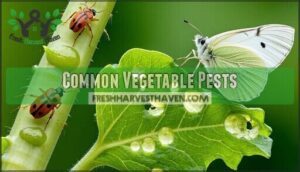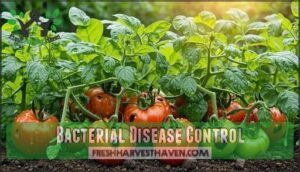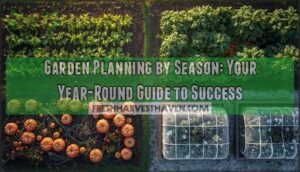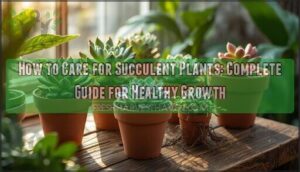This site is supported by our readers. We may earn a commission, at no cost to you, if you purchase through links.
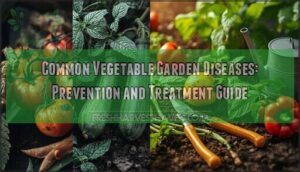 You’ll encounter common vegetable garden diseases like powdery mildew, blight, bacterial spot, and anthracnose throughout your growing season.
You’ll encounter common vegetable garden diseases like powdery mildew, blight, bacterial spot, and anthracnose throughout your growing season.
These diseases thrive in specific conditions—humid weather favors fungal infections, while bacterial problems spread through water splashes and contaminated tools.
Prevention beats treatment every time: choose resistant varieties, rotate crops annually, space plants properly for air circulation, and water at soil level instead of overhead.
Early detection matters since most diseases become unstoppable once they establish, and your best defense combines good garden hygiene, proper watering techniques, and understanding which diseases target your specific vegetables during different weather patterns.
Table Of Contents
- Key Takeaways
- Vegetable Disease Prevention
- Common Vegetable Pests
- Fungal Disease Management
- Bacterial Disease Control
- Integrated Pest Management
- Frequently Asked Questions (FAQs)
- How do I know what disease my plant has?
- What is a good fungicide for vegetable garden?
- What bug is eating my vegetable garden?
- What are the symptoms of disease in vegetables?
- How to identify waterlogging damage in vegetable plants?
- What causes curling leaves in vegetable seedlings?
- How does humidity impact vegetable disease development?
- Are there signs of calcium deficiency in vegetables?
- How to manage white rot in garlic and onions?
- What diseases affect tomato plants most commonly?
- Conclusion
Key Takeaways
- Prevention beats treatment – Choose disease-resistant varieties, rotate crops annually, and maintain proper plant spacing with good air circulation rather than trying to cure established infections.
- Water smart to prevent fungal diseases – Water at soil level during morning hours instead of overhead watering, which creates humid conditions that encourage powdery mildew, blight, and other fungal problems.
- Watch for early warning signs – Monitor your plants weekly for yellowing leaves, unusual spots, wilting, or stunted growth so you can remove infected material immediately before diseases spread.
- Practice good garden hygiene – Clean your tools between plants, remove diseased plant debris promptly, and clear your garden each fall to eliminate overwintering pathogens.
Vegetable Disease Prevention
Starting your vegetable garden with the right prevention strategies can save you from countless headaches later in the growing season.
You’ll protect your plants from common diseases by choosing proper sites, preparing healthy soil, rotating crops, and selecting resistant varieties.
Site Selection
Looking at site selection from a disease prevention perspective, you’ll want to scout for spots that naturally discourage problems.
Choose locations with these disease-fighting features:
Pick spots where sun shines bright, water drains fast, and fresh air flows freely.
- Sunlight Exposure: Find areas getting 6-8 hours of direct sun daily—light kills pathogens and dries moisture.
- Soil Drainage: Test spots after heavy rain; standing water invites root rot and fungal issues.
- Air Circulation: Pick open areas where breezes flow freely, preventing humid microclimates that harbor disease.
- Water Access: Make certain convenient irrigation to maintain consistent moisture without overwatering.
Proper drainage can be achieved by aerating garden beds.
Soil Preparation
Proper soil preparation sets the foundation for healthy plants and effective disease prevention. Start with soil testing to check pH levels and nutrient balance. Most vegetables thrive in slightly acidic to neutral soil (pH 6.0-7.0).
Add organic matter like compost or well-aged manure to improve soil health and structure. These soil amendments boost beneficial microbes that fight soilborne diseases. For heavy clay soils, work in coarse sand or perlite for better drainage improvement. A reliable testing method can provide valuable insights.
| Amendment Type | Purpose | Application Rate | Best For | Notes |
|---|---|---|---|---|
| Compost | Nutrient balance, soil structure | 2-4 inches | All vegetables | Improves water retention |
| Lime | Raises pH | Per soil test results | Acidic soils | Apply fall before planting |
| Sulfur | Lowers pH | 1-2 lbs per 1000 sq ft | Alkaline soils | Takes months to work |
| Perlite | Drainage improvement | 10-20% by volume | Heavy clay | Permanent soil structure |
| Aged manure | Organic matter, nutrients | 2-3 inches | Root vegetables | Must be well-composted |
Poor drainage creates perfect conditions for root rot and other fungal problems. Soil sterilization through solarization can eliminate existing pathogens before planting.
Crop Rotation
Crop rotation breaks disease cycles that plague your vegetable garden.
You’ll prevent soil health degradation by moving plant families to different beds every three to four years.
This simple garden maintenance practice disrupts pest cycles and supports nutrient management.
Family rotation means grouping tomatoes, peppers, and eggplants together, then relocating them as one unit.
The rotation benefits include reduced fungicide use and stronger plants.
Your soil rebuilds naturally between crops, creating a self-sustaining system for disease prevention.
Resistant Varieties
Smart variety selection builds on crop rotation to prevent plant diseases in your vegetable garden.
Disease resistance genes and breeding techniques create varieties that naturally fight common problems. Choose varieties with proven disease tolerance for your area.
You can also explore options for purchasing resistant seeds to further protect your crops.
- Select locally-adapted varieties with genetic diversity for your climate
- Choose heirloom resistance varieties that withstand regional plant diseases
- Consider grafting options for tomatoes and peppers to boost plant health
- Buy certified seeds from reputable sources with clear resistance labels
- Match varieties to specific diseases common in your garden
Common Vegetable Pests
You’ll encounter several destructive pests that can quickly damage your vegetable crops if left unchecked.
Understanding these common culprits and their warning signs helps you take swift action before they destroy your harvest.
Cucumber Beetles
Beetle Identification starts with recognizing these yellow-green striped or spotted cucumber beetles in your vegetable garden.
These garden pests create small holes in leaves and spread plant diseases like bacterial wilt.
Their lifecycle details show they overwinter in soil debris.
Damage symptoms include wilted plants and chewed foliage.
Natural predators like ground beetles help with pest control.
Organic control methods include row covers, beneficial nematodes, and neem oil sprays for effective management.
Flea Beetles
When flea beetles invade your vegetable garden, you’ll notice small shothole patterns across leaves.
These tiny garden pests jump like fleas when disturbed, targeting young seedlings most aggressively.
Flea beetle damage weakens plants through host plant selection preferences for brassicas and nightshades.
Combat them using natural predators like beneficial nematodes or apply organic control methods such as diatomaceous earth for effective plant protection.
Root Knot Nematodes
Below the soil, root knot nematodes destroy plants through their nematode life cycle.
You’ll notice yellowing, wilting, and stunted growth despite proper watering. Check roots for characteristic galls or swellings.
Combat these microscopic pests using soil solarization, cover cropping with marigolds, resistant rootstocks, and biological controls.
Effective disease management requires crop rotation to break their cycle and prevent devastating root rot in your vegetable garden.
Aphids
While root knot nematodes attack below ground, aphids wage war on your vegetable garden’s leaves and stems.
These tiny green, black, or yellow insects multiply rapidly, weakening plants through constant sap feeding.
Aphid Identification becomes easier when you know their clustering patterns on new growth. Understanding the Aphid Lifecycle helps time treatments effectively.
Control strategies include:
- Natural Predators like ladybugs and lacewings provide ongoing pest control
- Companion Planting with aromatic herbs deters infestations
- Insecticidal Soaps offer safe, targeted treatment options
- Regular monitoring prevents small problems from becoming garden pests disasters
Fungal Disease Management
Fungal diseases can quickly destroy your vegetable garden if left unchecked, but early identification and proper treatment will save your crops.
These common fungal problems spread rapidly in warm, humid conditions, so you’ll need to act fast when symptoms appear, and proper treatment is essential to saving your crops.
Septoria Leaf Spot
Septoria Leaf Spot strikes tomato plants with small, gray-centered spots on lower leaves. This fungal disease thrives in humid conditions, spreading through water splashes and contaminated tools.
Septoria symptoms include yellowing leaves that drop early, weakening plants substantially. The disease cycle continues through infected debris overwintering in soil.
Treatment options include copper fungicides and removing affected foliage promptly. Improving airflow and proper watering can help with disease prevention methods.
Improve airflow between plants and avoid overhead watering to reduce spread factors effectively.
Powdery Mildew
Powdery mildew appears as white, chalky dust across your vegetable leaves. This fungal disease thrives in warm, humid conditions with poor air circulation. Mildew identification starts with spotting that telltale coating on cucumbers, zucchini, and tomatoes.
Here’s your action plan for organic control:
- Space plants properly for better airflow
- Water at soil level to prevent spore dispersal
- Apply baking soda spray (1 tablespoon per gallon)
- Remove infected leaves immediately
- Choose resistant varieties for disease prevention
Environmental factors like high humidity fuel outbreaks, so good garden hygiene beats fungicides every time.
Downy Mildew
Any gardener knows that downy mildew strikes when conditions turn humid and cool.
DM identification starts with angular yellow spots on leaves and gray mold underneath.
Prevent this fungal disease with these steps:
- DM Prevention: Choose resistant varieties and improve airflow
- DM Spread Control: Water at soil level, not leaves
- DM Treatment: Apply copper fungicides early for effective disease prevention
Anthracnose
When fruit develops circular, sunken spots, you’re likely dealing with anthracnose—a destructive fungal disease that thrives in warm, wet conditions.
Anthracnose symptoms include dark lesions with orange spore masses that appear on tomatoes, cucumbers, beans, and peppers.
The fungus overwinters in plant debris, making garden cleanup essential for anthracnose prevention. For effective anthracnose treatment, remove infected fruits immediately and avoid overhead watering.
Anthracnose identification becomes easier when you spot the characteristic sunken lesions with pink spore centers. This disease spreads rapidly through spore dispersal during humid weather, affecting multiple anthracnose hosts in your garden.
Successful disease management requires understanding plant disease symptoms and implementing proper vegetable diseases control measures to protect your harvest.
Bacterial Disease Control
Bacterial diseases in your vegetable garden spread quickly through water, wounds, and contaminated tools, making early identification essential for protecting your crops.
You’ll need to recognize the warning signs of bacterial spot, blight, Stewart’s wilt, and blossom end rot to prevent widespread damage to your tomatoes, peppers, corn, and other vegetables.
Bacterial Spot
Throughout vegetable gardens, bacterial spot creates distinctive water-soaked lesions on tomato and pepper plants.
This bacterial infection spreads rapidly through water splash and contaminated tools, making early spot identification essential for effective disease management.
- Remove infected plant debris immediately to prevent disease spread
- Install drip irrigation systems to keep foliage dry during watering
- Apply copper-based bactericides as preventive treatment options
- Select resistant cultivars for long-term prevention tips against bacterial infections
Bacterial Blight
Bacterial blight strikes like wildfire, creating water-soaked spots that quickly turn brown and spread across leaves.
This bacterial disease thrives in warm, wet conditions and targets beans, peppers, and spinach with devastating efficiency.
You’ll need to focus on bacterial disease prevention through certified seeds and proper spacing.
The disease lifecycle accelerates during humid weather, making spread prevention essential for bacterial disease management.
| Aspect | Details | Prevention Tips |
|---|---|---|
| Blight identification | Water-soaked lesions, rapid browning | Check plants weekly for early symptoms |
| Disease spread | Splashing water, contaminated tools | Use drip irrigation, sanitize equipment |
| Treatment options | Copper sprays, resistant cultivars | Apply preventive treatments before symptoms |
| Bacterial disease symptoms | Leaf spots, wilting, plant decline | Remove infected debris immediately |
Stewart’s Wilt
Throughout corn-growing regions, Stewart’s wilt strikes when corn flea beetles transmit Pantoea stewartii bacteria. This bacterial wilt creates yellow streaks along leaf veins, progressing to wilting and plant death.
The disease cycle depends on beetle survival through winter months. Bacteria can cause bacterial leaf spot.
Effective vector control and disease prevention strategies include:
- Plant resistant corn varieties to reduce disease susceptibility
- Apply systemic insecticides targeting corn flea beetles early season
- Practice crop rotation to break the disease cycle
- Monitor beetle populations for outbreak prediction
- Remove infected plant debris to limit bacterial survival
Blossom End Rot
Dark spots appearing on your tomato bottoms signal blossom end rot, a frustrating plant disease affecting fruit development.
This calcium deficiency stems from inconsistent watering practices and improper soil pH levels.
You’ll prevent this garden problem by maintaining steady moisture, testing calcium levels, and choosing varieties with lower variety susceptibility.
Unlike bacterial tomato diseases, proper care easily manages this common vegetable garden issue.
Integrated Pest Management
Integrated pest management combines multiple strategies to protect your vegetable garden from diseases while minimizing environmental impact.
You’ll use biological controls, cultural practices, and targeted treatments together rather than relying on a single approach to achieve integrated pest management.
IPM Strategies
Successful IPM monitoring starts with regular pest identification and tracking economic thresholds to determine when action’s needed.
You’ll implement systemic approaches combining crop rotation, resistant cultivars, and garden sanitation for effective disease prevention.
This disease management strategy reduces reliance on reduced-risk pesticides while maintaining healthy plants through sustainable practices.
Biological Control
Beyond IPM strategies, biological control harnesses nature’s own pest-fighting army. Beneficial microbes like Bacillus subtilis suppress powdery mildew with 60-80% success rates, while predatory insects slash aphid populations by 65%. These biological microorganisms work around the clock for disease suppression.
- Natural enemies target specific pests without harming beneficial species
- Companion planting attracts helpful insects while repelling harmful ones
- Organic gardening methods boost soil health and support disease prevention
Chemical Control
Effective chemical control requires strategic timing and proper application techniques.
Apply fungicides like copper-based products 7-14 days before peak infection periods for maximum disease resistance.
Bactericides usage demands precise dosage control to prevent resistance development. Rotate different chemical modes of action between applications.
For those seeking further assistance, consider exploring options for effective fungal solutions.
Always follow label instructions for chemical timing and pre-harvest intervals to guarantee safe, effective fungal disease control and bacterial infections control.
Cultural Control
Through proper cultural practices, you’ll create conditions that naturally discourage disease development. Crop rotation disrupts pathogen cycles while resistant varieties provide built-in protection against common problems.
Essential cultural practices include:
- Watering practices: Water at soil level during morning hours to reduce leaf moisture
- Plant spacing: Provide adequate room between plants for improved air circulation
- Sanitation methods: Remove infected plant debris and clean tools between uses
- Pruning techniques: Cut away diseased branches during dry weather conditions
- Soil solarization: Cover moist soil with clear plastic during hot summer months
These sanitation and spacing strategies form your foundation for effective disease prevention. Companion planting can also help, as biodiversity reduces outbreaks by 25%.
Physical Barriers
Physical barriers create your garden’s first line of defense against diseases and pests.
Row covers protect vulnerable seedlings while maintaining proper plant spacing reduces humidity that encourages fungal growth.
Netting options keep flying insects away from crops, and raised beds improve drainage for better disease prevention.
| Barrier Type | Primary Function | Best For | Maintenance Need |
|---|---|---|---|
| Row Covers | Pest exclusion, microclimate control | Young plants, cold protection | Weekly inspection |
| Copper Tape | Slug and snail deterrent | Raised bed edges, containers | Monthly cleaning |
| Mulch Types | Moisture retention, soil temperature | Root zones, pathways | Seasonal replacement |
| Garden Netting | Flying pest control | Fruiting crops, leafy greens | Post-harvest storage |
Combine these physical barriers with good garden hygiene and regular garden maintenance.
Proper garden sanitation removes disease sources while barriers maintain plant health through the growing season, utilizing physical barriers as a key component of disease prevention and ensuring proper plant spacing for a healthy garden ecosystem.
Frequently Asked Questions (FAQs)
How do I know what disease my plant has?
Like a detective at a crime scene, you’ll examine symptoms systematically.
Check leaves for spots, powdery coatings, or curling.
Note yellowing patterns, wilting, and root condition.
Compare findings to disease guides for accurate identification to ensure you understand the issue, and this will help in disease management.
What is a good fungicide for vegetable garden?
Copper fungicide spray works best for most vegetable garden fungal diseases. Apply it early when you first spot symptoms on leaves or stems for maximum effectiveness.
What bug is eating my vegetable garden?
Common culprits include aphids, caterpillars, flea beetles, cucumber beetles, squash bugs, and slugs.
Check for specific damage patterns—holes, chewed leaves, or sticky residue—to identify the pest and choose targeted treatment.
What are the symptoms of disease in vegetables?
You’ll spot yellowing, wilting, brown spots, white powdery coating, curled leaves, stunted growth, black lesions, or fuzzy mold on your vegetables indicating fungal, bacterial, or viral diseases.
How to identify waterlogging damage in vegetable plants?
Yellowing leaves, wilting despite moist soil, mushy brown roots, stunted growth, and a sour smell from soil indicate waterlogging damage in your vegetable plants.
What causes curling leaves in vegetable seedlings?
Curling leaves in vegetable seedlings typically result from overwatering, underwatering, temperature stress, or viral diseases like leaf curl.
Check soil moisture levels and adjust watering accordingly while ensuring proper temperature control, which can help prevent issues like leaf curl.
How does humidity impact vegetable disease development?
Picture your cucumber seedlings thriving one day, then collapsing with downy mildew the next after a humid night.
High humidity creates perfect conditions for fungal diseases like powdery mildew, downy mildew, and leaf spot to spread rapidly through your garden.
Are there signs of calcium deficiency in vegetables?
Yes, you’ll notice blossom end rot in tomatoes and peppers – dark, sunken spots on fruit bottoms.
This calcium deficiency stems from inconsistent watering and excess nitrogen, not actual calcium shortage in soil.
How to manage white rot in garlic and onions?
Like battling an invisible enemy, you’ll need strategic defense against white rot in your allium crops.
Remove infected bulbs immediately, improve soil drainage, and rotate crops for three years minimum to starve the persistent fungal spores.
What diseases affect tomato plants most commonly?
Tomato plants commonly face early blight, late blight, fusarium wilt, verticillium wilt, bacterial spot, mosaic virus, and blossom end rot.
You’ll notice yellowing leaves, wilting, spots, and stunted growth affecting your harvest.
Conclusion
An ounce of prevention is worth a pound of cure when managing common vegetable garden diseases in your backyard.
Success depends on consistent preventive practices rather than reactive treatments.
Choose disease-resistant varieties, maintain proper plant spacing, and water at soil level to minimize fungal spread.
Rotate crops annually and clean garden tools regularly.
Monitor plants weekly for early symptoms like yellowing leaves or unusual spots.
When diseases appear, remove affected plant material immediately and dispose of it away from your garden.
These simple strategies will keep your vegetables healthy throughout the growing season.


